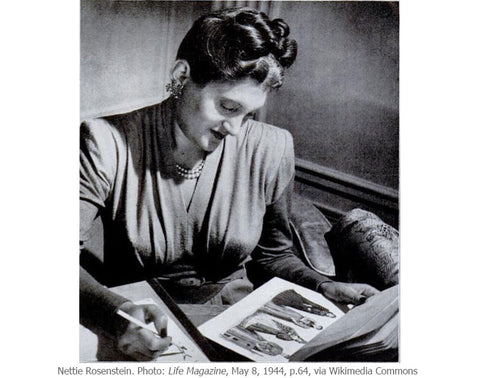
Women’s History Month has inspired me to research and write about women jewelry designers of the first half of the 20th century whose names you may not know. Most of the information about the freelance and in-house workers of the costume jewelry manufacturers in business in this period is lost. My latest research allows me to introduce you to several of these women and show you some of their work.
Nettie Rosenstein
Fashion designer Nettie Rosenstein (1891-1980) was a pioneer in American high-fashion ready-to-wear from 1921-1961. In 1942, she launched Nettie Rosenstein Accessories Corporation. Her product lines included costume jewelry, handbags, hosiery and perfume. This business continued until 1985.
Unlike fashion house owners such as Hattie Carnegie and Chanel, who both sold costume jewelry designed by others, Rosenstein, herself, designed most of the jewelry marked with her name until 1949. That year and the following, she collaborated with Sol Klein (Brunialti & Brunialti, 45). He later became the company’s sole designer.
Here are two 1940s pieces in gold-plated sterling by Nettie Rosenstein. On the left is a leaf lapel pin with a hinged, double-prong back. Its three-dimensional design features a layer of berries attached to stylized, openwork leaves, a motif she favored. The large (3 3/8” high) bow brooch on the right is embellished with diamantés and four turquoise glass cabochons.
 |
 |
Jewelry with this maker’s mark was of the highest quality. Although most costume jewelry manufacturers reverted to the use of base metals when World War II restrictions were lifted, Rosenstein continued using sterling until the mid-1950s (Brunialti & Brunialti, 45).
Although I’ve handled very few of her pieces, I truly admire Nettie Rosenstein’s unique and elegant jewels from the 1940s.
Elvira (Vera) De Rosa
Ralph De Rosa, Inc. was a family-owned and operated maker of high-quality costume jewelry founded in New York City in 1934. When Ralph died in 1942, his wife, Virginia, and two daughters, Teresa and Elvira (Vera), continued to run the business until 1955. Vera (1913-1980) definitely was a designer, but my research has not yet confirmed the extent of Virginia’s role in design.
These crescent ear clips, designed by Vera, are part of the company’s romantic “Dearest” series, highlighted in a September 9, 1949 Women’s Wear Daily article. The first letter of each gemstone color in the piece spell out the DEAREST love message. This style, which was popular in the Victorian era, is known as “acrostic” jewelry.
 My research uncovered some facts about Vera’s personal life. In 1951, she married Frank DeMario, brother of Robert DeMario, another costume jewelry manufacturer. The extensive wedding announcement in The Brooklyn Daily Eagle described the bride as “an executive partner of the Ralph De Rosa Company costume jewelry firm”. Her 1980 obituary in The Palm Beach Post stated that she “was the daughter of the noted jewelry designer Ralph De Rosa of Madison Avenue, New York”. The article enumerated her work for various charities. I think the omission of her own professional accomplishments is unfortunate but a sign of the times, when women in business operated out of the limelight.
My research uncovered some facts about Vera’s personal life. In 1951, she married Frank DeMario, brother of Robert DeMario, another costume jewelry manufacturer. The extensive wedding announcement in The Brooklyn Daily Eagle described the bride as “an executive partner of the Ralph De Rosa Company costume jewelry firm”. Her 1980 obituary in The Palm Beach Post stated that she “was the daughter of the noted jewelry designer Ralph De Rosa of Madison Avenue, New York”. The article enumerated her work for various charities. I think the omission of her own professional accomplishments is unfortunate but a sign of the times, when women in business operated out of the limelight.
Maria Vittoria Albani Scala & Simona Scala
Ornella Bijoux was founded in 1944 in Milan, Italy, as a result of wartime supply restrictions faced by a well-established cosmetics company and a fine jeweler. The former lacked the alcohol needed for perfume production, and the latter could only access gold brought in by customers. The two businesses decided to pool their resources and establish a costume jewelry brand created by the jeweler and distributed by the cosmetics firm.
When the war ended and supplies were again available, the cosmetics firm and fine jeweler agreed to abandon their collaboration and return to their original businesses. The cosmetic factory’s art director suggested that Piera Albani, his secretary and a widow, buy the costume jewelry samples and continue operating Ornella. She agreed, taking a huge risk in giving up her salaried position for this new venture. Her 14-year-old daughter, Maria, started working with her and three employees.
Maria took over designing the company’s handmade creations after the first few years. She was joined by her daughter Simona Scala at their atelier in central Milan, where Maria continued until her death in 2019. Simona continues the maison with the assistance of her daughter, who manages social media.
This beaded umbrella brooch, which I think is from the late-1940s to 1950s, illustrates the whimsical nature of some early designs as well as the fine craftsmanship and use of Italian materials that are the company’s hallmarks. I’ve decided to show this fun piece worn in a fun way – on a beach hat!

Starting from an abandoned wartime business, four generations of talented and courageous women have established an atelier of world renown, creating collections for fashionable shoppers as well as Haute Couture. In 2016, Fondazione Cologni Mestieri d’Arte, a foundation dedicated to the preservation and continuance of Italian artistic crafts, nominated Maria Vittoria Albani as Maître d’Art.
Other Women Jewelry Designers
Because these women and their colleagues have remained anonymous for decades, I want to acknowledge and document their talents and contributions. One of my goals as a costume jewelry historian is to tell the stories of the unsung heroes who created the jewels we collectors covet today. I’m happy to sing their praises now.
In celebration of an earlier Women’s History Month, I wrote an extensive post about The Woman Behind Eisenberg’s Sparkle: Ruth Kamke. While researching this month’s blog, I identified two more women jewelry designers whom I’d like to tell you about. So stay tuned!
Printed Sources Cited
Brunialti, Carla Ginelli and Roberto Brunialti. American Costume Jewelry: Arts & Industry, 1935-1950. Schiffer, 2008.
“Elvira De Rosa, Mr. DeMario Wed.” The Brooklyn Daily Eagle, August 20, 1951, p.11.
“Elvira L. DeMario.” The Palm Beach Post, November 26, 1980, p.29.
“Inspired by Boticelli Art.” Women’s Wear Daily, September 9, 1949, p.18.

1 comment
Hello Barbara… This Blog was well written and very interesting. I especially enjoyed reading about Nettie Rosenstein. I have always gravitated towards 1940 jewellrey, and like the boldness and size of the pieces.
Thank you for continuing to research, and enlighten us with your knowledge.
Sincerely Patsy Campbell
Leave a comment